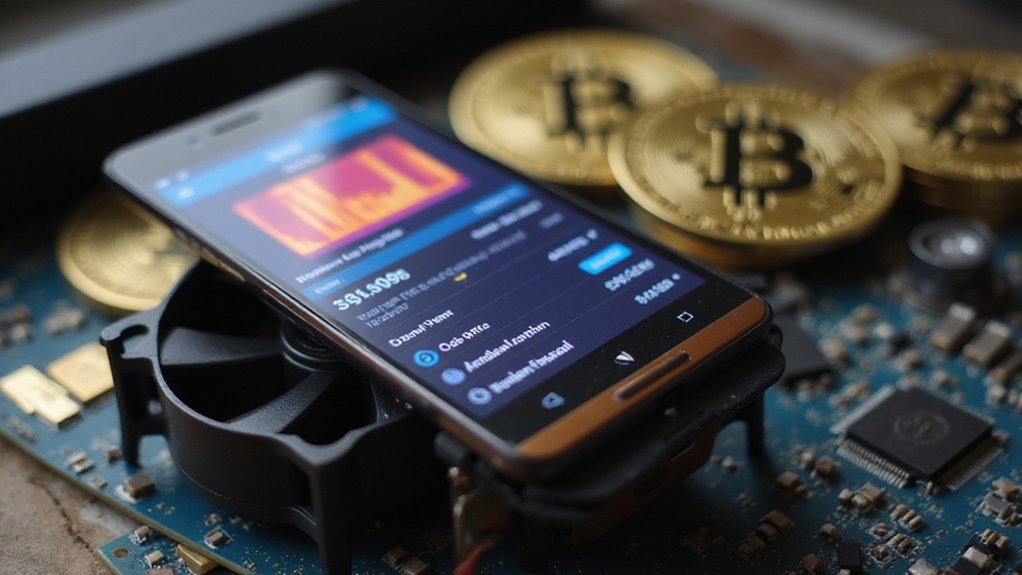Mining Bitcoin on Android remains technically possible but financially absurd. Smartphones generate mere megahashes while industrial ASICs operate at petahash levels—like racing a tricycle against hypersonic jets. The process devours battery life, generates negligible returns, and accelerates device deterioration. Apps like CryptoTab Browser facilitate this exercise in economic futility, though joining mining pools slightly mitigates the mathematical impossibility. The educational value may justify the experiment for those curious about cryptocurrency’s infrastructure beyond the theoretical.

Why would anyone consider mining Bitcoin on a smartphone when purpose-built ASIC machines dominate the industry? The question itself betrays a fundamental misalignment of technological capability and cryptocurrency economics, yet curiosity persists—perhaps driven by the democratizing ethos that once defined Bitcoin’s early days.
The stark reality is that Android devices (indeed, all mobile platforms) face insurmountable handicaps in the competitive mining landscape.
Mobile devices exist as mere technological spectators in the ruthless arena of Bitcoin mining economics.
Contemporary Bitcoin mining demands specialized ASIC hardware operating at petahash speeds, while smartphones lack both the computational architecture and thermal management systems required for such intensive calculations. Even with the latest processors, a typical smartphone produces extremely low hashrates compared to dedicated mining equipment.
The reward mechanism—now hovering at 6.25 BTC per block—further diminishes any realistic return prospects when divided among mining pool participants, let alone solo miners wielding mere megahashes of processing power.
For the determinedly experimental, the process begins with securing a reputable mining application (CryptoTab Browser being among the more established options) and creating the requisite account. Most mobile mining apps are simply cloud-based methods rather than performing actual device-based mining.
Joining a mining pool becomes not merely advantageous but essential—transforming a mathematical impossibility into merely a financial impracticality.
The pooled approach distributes fractional rewards based on contributed computational effort, though even these arrangements yield returns that barely register against power consumption costs.
The resource implications cannot be overstated: battery depletion accelerates dramatically, processing capacity for other applications diminishes, and device longevity potentially contracts. Continuous mining operations would cause significant strain on your device, substantially reducing its lifespan while offering virtually no financial return.
iPhone users fare no better, facing identical hardware limitations and efficiency constraints despite operating system differences.
What emerges, then, is less a viable income strategy than an educational exercise—a hands-on introduction to cryptocurrency mechanics without significant financial exposure.
Participants gain practical insight into blockchain verification processes, difficulty adjustments, and network consensus mechanisms that underpin the entire cryptocurrency ecosystem.
Perhaps the most valuable lesson from Android Bitcoin mining isn’t about profitability but perspective: understanding firsthand why industrial-scale operations have evolved to dominate this space, with warehouses of specialized equipment representing the economic reality of contemporary cryptocurrency production.¹
¹The evolution from CPU to GPU to ASIC mining reflects Bitcoin’s maturation from academic experiment to global financial infrastructure.
Frequently Asked Questions
How Much Electricity Does Android Bitcoin Mining Consume?
Android Bitcoin mining consumes substantially less electricity than specialized mining rigs, yet the energy expenditure remains disproportionate to potential returns.
While precise consumption varies by device model and processing power, the electricity used—typically between 2-5 watts during mining operations—represents a fraction of professional setups.
However, this apparent efficiency is largely moot; the computational limitations render Android mining basically futile, transforming one’s smartphone into little more than an expensive hand-warmer with negligible mining output.
Can Mining Damage My Android Device Over Time?
Mining can indeed inflict significant damage on Android devices over time.
The persistent overheating—a natural byproduct of the intensive computational processes—stresses internal components, while excessive battery cycling accelerates degradation.
Furthermore, the constant processor strain (operating at near-maximum capacity) diminishes hardware longevity.
What few realize is that these cumulative effects effectively exchange device health for negligible cryptocurrency returns—a trade-off that, upon even cursory financial analysis, reveals itself as remarkably unfavorable for all but the most dedicated digital masochists.
What Bitcoin Mining Apps Are Available for Android?
Several Bitcoin mining options exist for Android, though most employ cloud mining rather than device-based processing.
Established platforms like ECOS, StormGain, and Binance Pool offer cloud services without taxing device resources.
Task-based alternatives include CryptoTab Browser and Pi Network, which reward users for activities rather than computational work.
For the intrepid few willing to sacrifice battery life, MinerGate and MobileMiner utilize on-device processing—though returns rarely justify the hardware strain¹.
¹As previously discussed, such device-intensive mining can potentially damage Android hardware over time.
Is Mining on Android Profitable Compared to PC Mining?
Mining on Android is fundamentally unprofitable compared to PC mining.
While a dedicated PC rig with ASICs can generate measurable returns (especially with optimized hardware and favorable electricity costs), Android devices produce negligible hash rates—thousands to millions of times lower than specialized equipment.
The economics simply don’t compute: smartphones suffer accelerated hardware deterioration and battery degradation while yielding virtually no mining output.
The notion of profitable Android mining borders on financial fantasy in today’s competitive cryptocurrency landscape.
Do I Need to Root My Android Device for Bitcoin Mining?
Rooting an Android device is unnecessary for Bitcoin mining—a fact that might surprise the uninitiated.
Contemporary mining applications operate comfortably within standard user permissions, connecting to pools or managing remote operations rather than performing intensive on-device computation.
The risk-reward calculus simply doesn’t compute; rooting introduces significant security vulnerabilities and warranty complications while offering negligible performance improvements.
For the aspiring mobile miner, legitimate apps from trusted developers present a far more prudent path forward.









